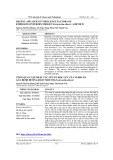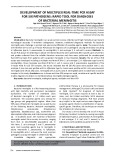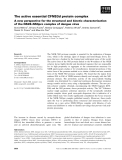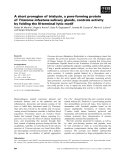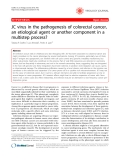
Etiological agents
-
Diarrhea is the leading cause of infant mortality worldwide, especially in the developing world. Among various etiologic agents within the Escherichia genus, Escherichia albertii is becoming recognized as a significant human enteropathogen. There has been little knowledge about the colonization and infection of E. albertii in comparison to its close relatives, E. coli.
 11p
11p  viinuzuka
viinuzuka
 28-02-2025
28-02-2025
 2
2
 1
1
 Download
Download
-
Bacterial meningitis is an acute central nervous infection with high mortality or permanent neurological sequelae if remained undiagnosed. The present study will therefore aim to set up in-house PCR assays for diagnosis of six pathogens causing the disease including H. influenzae type b, S. pneumoniae, N. meningitidis, S. suis serotype 2, E. coli and S. aureus.
 7p
7p  viuchiha
viuchiha
 03-01-2025
03-01-2025
 4
4
 2
2
 Download
Download
-
The NS2B–NS3 protease complex is essential for the replication of dengue virus, which is the etiologic agent of dengue and hemorrhagic fevers, dis-eases that are a burden for the tropical and subtropical areas of the world. The active form of the NS3 protease linked to the 40 residues of the NS2B cofactor shows highly flexible and disordered region(s)...
 13p
13p  inspiron33
inspiron33
 25-03-2013
25-03-2013
 44
44
 4
4
 Download
Download
-
Triatoma infestans(Hemiptera: Reduviidae) is a hematophagous insect that transmits the protozoan parasite Trypanosoma cruzi, the etiological agent of Chagas’ disease. Its saliva contains trialysin, a protein that forms pores in membranes. Peptides based on the N-terminus of trialysin lyse cells and fold into a-helical amphipathic segments resembling antimicrobial peptides. Using a specific antiserum against trialysin, we show here that trialysin is synthesized as a precursor that is less active than the protein released after saliva secretion. ...
 9p
9p  media19
media19
 06-03-2013
06-03-2013
 49
49
 2
2
 Download
Download
-
JC virus in the pathogenesis of colorectal cancer, an etiological agent or another component in a multistep process?
 8p
8p  dauphong4
dauphong4
 24-12-2011
24-12-2011
 38
38
 3
3
 Download
Download
CHỦ ĐỀ BẠN MUỐN TÌM








